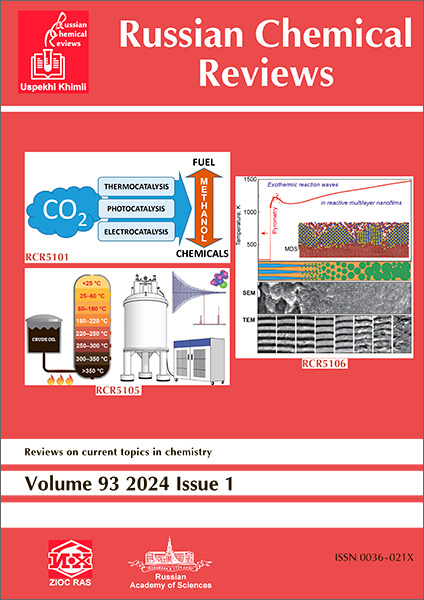Supercritical fluids in chemistry
IF 6
2区 化学
Q1 CHEMISTRY, MULTIDISCIPLINARY
引用次数: 22
Abstract
Dedicated the memory of Akademician Valery Vasilievich Lunin, a friend, colleague, teacher, founder and leader of the research into application of supercritical fluids in chemistry. This review analyzes the rapidly developing applications of supercritical fluids, mainly supercritical carbon dioxide, in catalysis, chemistry of high-molecular-weight compounds, and medicinal chemistry in Russia and abroad. It considers the methods of catalyst preparation based on impregnation of inorganic and organic supports with metal-containing compounds, immobilization of organometallic and metal complex reagents in matrices of oxide and polymer supports, and deposition processes employing supercritical fluids. An analysis is presented of the prospects for applying CO2 and some organic compounds, such as aliphatic alcohols, in sub- and supercritical states as reactants and (or) solvents for catalytic reactions of hydrocarbon isomerization and cracking, hydrogenation, dehydrogenation, oxidation, etc., including the asymmetric reactions. The review discusses processes of synthesizing and modifying polymer materials for various purposes, including aerogels, foams, and composites impregnated with photochromes, in a supercritical fluid medium. Special attention is paid to supercritical one-pot processes, which make the techniques of obtaining new materials simpler, less expensive, and more efficient. The work investigates the effect of supercritical CO2 on the morphology, gas separation characteristics, and dielectric properties of polymers. One of the promising applications of supercritical fluids in medicine is the use in transplantology and pharmacology, for example, for the preparation of drug polymorphs with higher bioavailability. The review also provides an overview of the recent data on the use of EPR spectroscopy for studying the properties of supercritical fluids, including those exhibited in the vicinity of the critical point and identifying the intermediates of chemical reactions in such media. The bibliography includes 1151 references.化学中的超临界流体
献给阿卡德米西亚·瓦西里耶维奇·鲁宁,他的朋友、同事、老师、超临界流体在化学中应用研究的创始人和领导者。本文综述了超临界流体(主要是超临界二氧化碳)在俄罗斯和国外催化、高分子量化合物化学和药物化学中的快速发展应用。它考虑了基于用含金属化合物浸渍无机和有机载体、将有机金属和金属络合物试剂固定在氧化物和聚合物载体基质中以及使用超临界流体的沉积过程的催化剂制备方法。分析了CO2和一些亚超临界和超临界状态的有机化合物,如脂肪醇,作为反应物和(或)溶剂用于烃类异构化和裂化、氢化、脱氢、氧化等催化反应的前景,包括不对称反应。综述了在超临界流体介质中合成和改性各种用途的聚合物材料的过程,包括气凝胶、泡沫和用光致变色材料浸渍的复合材料。特别关注的是超临界一锅法,它使获得新材料的技术更简单、更便宜、更高效。研究了超临界CO2对聚合物形态、气体分离特性和介电性能的影响。超临界流体在医学中的一个有前途的应用是在移植学和药理学中的应用,例如,用于制备具有更高生物利用度的药物多晶型物。该综述还概述了EPR光谱用于研究超临界流体性质的最新数据,包括在临界点附近表现出的超临界流体的性质,并鉴定了此类介质中化学反应的中间体。参考书目包括1151篇参考文献。
本文章由计算机程序翻译,如有差异,请以英文原文为准。
求助全文
约1分钟内获得全文
求助全文
来源期刊

Russian Chemical Reviews
化学-化学综合
CiteScore
13.00
自引率
5.20%
发文量
27
审稿时长
6-12 weeks
期刊介绍:
Russian Chemical Reviews serves as a complete translation of the esteemed monthly review journal Uspekhi Khimii, which has been a prominent figure in Russian scientific journals since its establishment in 1932. It offers comprehensive access to the advancements made by chemists from Russia and other former Soviet Union countries.
Established in 1932, Russian Chemical Reviews is committed to publishing timely and significant review articles encompassing various facets of modern chemistry, including chemical physics, physical chemistry, computational and theoretical chemistry, catalysis, coordination chemistry, analytical chemistry, organic, organometallic, and organoelement chemistry, chemistry of macromolecules, applied chemistry, biochemistry, bio-organic chemistry, biomolecular chemistry, medicinal chemistry, materials chemistry, nanochemistry, nanostructures, and environmental chemistry.
 求助内容:
求助内容: 应助结果提醒方式:
应助结果提醒方式:


